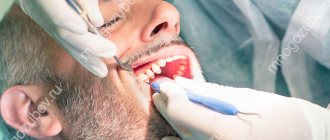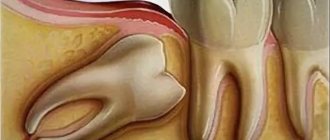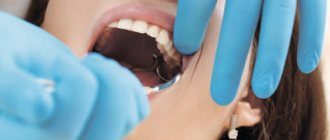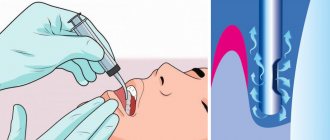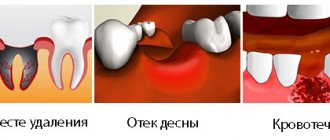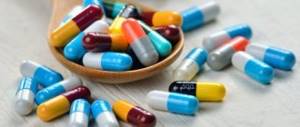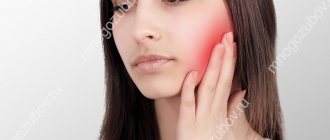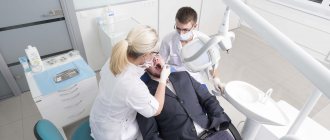From this article you will learn:
- Is it possible to rinse your mouth after removal,
- how to do it right,
- the better to rinse after tooth extraction.
The article was written by a dental surgeon with more than 19 years of experience.
Mouth rinsing after tooth extraction is the most common prescription prescribed by a dental surgeon after oral surgery. In most cases, solutions of antiseptics (medicines with antimicrobial activity) are used for mouth rinsing, or in some cases, saline solutions will be optimal. Most often, rinses are prescribed only after a complex tooth extraction, or if the extraction was carried out against the background of purulent inflammation.
Regular rinsing of the mouth with antiseptics can reduce the risk of developing alveolitis by approximately 80%, i.e. inflammation of the socket of an extracted tooth. However, if the patient rinses the mouth incorrectly, this, on the contrary, can lead to the blood clot falling out of the socket, the development of inflammation of the socket and the need for long-term treatment.
In addition to antiseptic solutions and soda-saline solutions, combined rinses can also be used, which, in addition to the antiseptic, additionally contain one or more anti-inflammatory components. Usually the latter are high concentrations of medicinal plants, which are found in a number of rinses. Such components additionally have a wound-healing effect, accelerating gum epithelization.
Why do you need rinses when a tooth is pulled out?
In the first 24 hours after tooth extraction, there is no need to rinse the mouth, as this can worsen the healing process. To understand why you shouldn’t do this, mentally return to the dental chair and remember what manipulations the doctor performed after removing the disturbing tooth.
First of all, the dental surgeon visually and using a curettage spoon probes the alveolus - the place where the roots of the tooth were located. This manipulation is necessary to make sure that there are no root fragments left. If the removal was in the upper jaw, then when examining the hole, the doctor checks the integrity of the bone, and also whether a connection has formed with the maxillary sinus.
After bringing the edges of the wound together with a gauze swab, the dentist recommends grasping it tightly with your teeth and holding it for a quarter of an hour.
These manipulations allow the formation of a blood clot, the main function of which is to protect the fresh wound from possible infection. If the patient decides to rinse his mouth after a short time, then most likely he will wash out this clot.
Aggressive rinsing destroys the protective blood barrier at the site of the extracted tooth, which leads to the development of alveolitis - an inflammatory process in the socket. It is accompanied by pain and an unpleasant odor, and the bone wound and gums cannot heal for a long time.
And yet, rinses are often used both by patients themselves and prescribed by doctors. It is definitely impossible to answer the question of whether it is necessary to rinse.
Mouth rinse has certain functions:
- reduces the severity of pain;
- eliminates microbes that contaminate the oral cavity;
- reduces the period of wound healing in the presence of purulent discharge.
Features of wisdom teeth
Third molars are located deep in the mouth, at the very end of the lower and upper rows. Their differences from other teeth consist not only in such a delayed and slow eruption, but also in the development of complications accompanying this process.
Wisdom teeth are similar in structure to regular chewing teeth: they have a wide crown with cusps, several roots (2 on the lower jaw and 3 on the upper jaw). They usually do not have enough space at the end of the row, and in the immediate vicinity there are ligaments and chewing muscles attached that prevent these teeth from growing. Therefore, the “eights” tilt to the side, rest against the cheek, against the “neighbors,” or cannot cut through at all. Hence the unbearable pain.
The hygiene of third painters is difficult, so their enamel is quickly destroyed. In addition, if they rest against nearby teeth, they destroy them too.
Let's list the troubles that can be expected from wisdom teeth:
- caries - damage to the enamel, its blackening and the appearance of a hole;
- pericoronitis - inflammation of the tissues surrounding the tooth, and the formation of a mucous membrane over it - the so-called “hood”, under which food debris gets trapped, forming plaque. This provokes an unpleasant odor and inflammation with high temperature in this area;
- movement of other teeth in the row leading to pain (for example, canines);
- chronic cheek biting;
- compression of the branches of the ternary nerve, leading to numbness of part of the jaw and unpleasant sensations;
- the development of a cyst provoked by the presence of chronic inflammation around the tooth.
Based on the problems described above, it is quite clear that wisdom teeth have to be treated or removed, although this is difficult to do due to their location and also because their roots are either fused or intertwined.
Indications
If the tooth extraction was planned, it did not hurt, there was no purulent discharge, then there is no point in rinsing. In a healthy person with a strong immune system, overgrowth occurs on its own, without additional manipulation.
The main indication for performing such a procedure is the order of the surgeon who performed the removal. When pus is found in the hole during extirpation, the doctor prescribes medications and explains how to make oral baths.
Rinsing will be beneficial and promote speedy healing in the following cases:
- Inflammatory phenomena - if the tooth was very painful before, there was swelling, pulsation or an increase in temperature - these are signs of the accumulation of purulent exudate.
- Periostitis - when, simultaneously with tooth extraction, an incision was made on the gum due to “flux”.
- Decayed teeth - if there are carious lesions and other sources of infection in the mouth, then rinsing will protect the hole from infection.
Thanks to rinsing, pathogenic microorganisms die, but you should always remember that such manipulation should be gentle and, hiding behind the imaginary benefits, not cause even more harm.
During pregnancy and breastfeeding
"Chlorhexidine" is indicated for use by women during pregnancy and breastfeeding, but only if the patient does not have open wounds or cuts in her mouth. The drug has a superficial effect and is not absorbed into the blood or breast milk.
When breastfeeding, the drug can also be used
For small patients, the preferred form is a spray - it does not require rinsing skills to use. With its help, you can easily treat any areas of the oral mucosa. However, Chlorhexidine should not be used on children under 3 years of age, in particular for irrigating the tonsils. In both cases, the maximum permissible course duration should not exceed 10 days, and the use of the drug must be agreed with a doctor.
Contraindications
No need to rinse:
- if less than 24 hours have passed since surgery;
- if there was no medical prescription;
- with a sanitized oral cavity and a good state of the immune system, rinsing will do more harm than good;
Neglecting the doctor’s recommendations can cause consequences:
- Bleeding from the socket that occurs repeatedly.
- Development of inflammatory processes such as osteomyelitis and alveolitis.
- Suppuration of the soft tissues that surround the tooth.
This explains why and in what cases it is better not to rinse your mouth after removal.
pharmachologic effect
The active substance chlorhexidine destroys the bacterial lash, which leads to its gradual destruction. It is not able to cope with viruses , so dentists do not prescribe it for viral infections, with the exception of herpes.
The product has good resistance to environmental factors. After rinsing, the film remains on the mucous membranes for several hours, which is necessary to treat the disease. It is good if, before rinsing, the patient warms up the liquid a little, as this increases the antiseptic intensity. The effect persists even in a purulent environment and blood admixture.
- The benefits and harms of rinsing the mouth with sunflower oil
The use of chlorhexidine has a beneficial effect on the restoration of the body's protective cells. Chlorhexidine copes with inflammatory processes, reduces hyperemia, swelling, and promotes the regeneration of mucous tissues.
Is it possible to rinse and when to do it?
A day after tooth extraction, rinsing is acceptable in some situations, but these are more likely to be oral baths than active washing procedures.
Few people have an oral cavity in perfect condition. Caries, loose teeth, plaque and stones, and often rotten tooth roots are not the best neighbors for the bleeding surface of the alveoli. Mouth baths will reduce the risk of infection penetrating deep into the socket.
When carrying out a hygienic procedure aimed at combating inflammation, you should remember:
- active rinsing movements will do more harm than good;
- For the first 24 hours, limit yourself to gentle brushing of your teeth;
- if pain occurs during the procedure, rinsing should be stopped;
- If bleeding resumes, visit a doctor immediately.
In addition, do not forget the dentist’s recommendations: do not eat hot food, do not lift heavy objects, and do not touch the socket with your hands and tongue.
Indications for removal and its nuances
Particularly lucky people are lucky: their “eights” cut through well and evenly. Experts recommend saving such teeth, but usually their nerves are removed, treated, and crowns are placed on them, preventing damage to the enamel. In other cases (see above), removal is the only way to get rid of dental diseases and pain.
Removal, as already mentioned, is complicated by the location of the molar deep in the mouth, in the thickness of the bone, the presence of inflammation, pus, and pain in the patient when opening the mouth. The doctor uses strong anesthesia and special instruments: forceps and elevators that remove individual roots.
After the operation, the pain in the jaw remains for some time and the wound bleeds a little. Swelling of the cheek is observed, usually after removal of a molar on the lower jaw - this is due to its structure and the body’s reaction to such an intervention. It may get stronger. There is also pain in the gums and cheeks when opening the mouth, eating and swallowing, and there may even be an increase in body temperature by several degrees. How long this will last depends on the patient’s health, the complexity of each individual case, the patient’s compliance with the doctor’s recommendations, etc. So, for some people everything goes away within three days, and for others whose gums were inflamed, there was pus or the dentist had to make an incision, healing will occur in five to seven days.
In any case, you need to follow the doctor’s recommendations so that healing takes place in a short time and with good quality. To make wisdom tooth removal comfortable, painless and quick, call and come to the Narodnaya dental clinic, where each patient is treated with care and attention.
How to rinse your mouth after tooth extraction: list of products
- Chlorhexidine is the most common pharmaceutical drug. It is a colorless, transparent liquid that has a slight odor and bitter taste. For dental purposes it is used in a concentration of 0.05%. It has an antiseptic effect and is active against a wide range of microorganisms, with the exception of fungi and viruses. Contraindicated for use by pregnant women and children due to possible ingestion. To rinse, you need to put a small amount of solution in your mouth; dilution in water is not required;
- Miramistin - unlike its predecessor, Miramistin has a wider spectrum of antibacterial action, and also affects viruses and fungi of the genus Candida. The drug improves local immunity of the oral cavity and promotes better healing. Actively affects pus-forming bacteria. Available in plastic bottles and in the form of a spray, so it can be used for oral baths and irrigations. Doesn't get into the blood. Can be prescribed to pregnant and lactating women;
- a solution of soda and salt - the combination of these two substances has an antiseptic effect. To enhance the effect, it is recommended to add a couple of drops of iodine tincture. Dissolve 7-10 grams of soda and salt in 250 ml of boiled water; it is important that the water is not cold. Rinse 2-3 times a day. However, you should be very careful. Vigorous rinsing with such a solution can not only remove the clot, but also irritate the wound, so it is better to give preference to other, less aggressive methods;
- Furacilin - perfectly exhibits its properties as an antiseptic in the treatment of purulent-inflammatory processes. To prepare the solution, take 10 tablets per 1 liter of water. To make the tablets dissolve better, you can crush them first and use hot water. Should be used in the form of oral baths for 1-2 minutes 3-4 times a day;
- herbs - decoctions based on herbs, such as chamomile, calendula or sage, have proven themselves as gentle remedies that are effective in various types of inflammatory processes. When using a herbal decoction as oral baths, the healing rate of the extracted tooth socket increases;
- potassium permanganate is an antiseptic familiar from childhood, with which you should be very careful, because a large concentration or undissolved crystals of the substance cause a burn to the mucous membrane and even an allergic reaction. For this reason, this substance is not available for free trade;
- rinses - this oral care product is in some cases also applicable for rinsing after tooth extraction surgery. This applies to balms used for gum disease. Extracts of eucalyptus, pine needles, calendula or oak bark have a good wound healing effect. Can be used 2-3 times a day.
If something white appears in the hole after removal, then do not panic.
What are the advantages and disadvantages?
The drug is widely used in dental practice, and there is a whole list of good reasons for this. Experts cite the following points as the main advantages of “Chlorhexidine” for mouth rinse:
- helps in the fight against pathogenic microflora,
- has a wide range of antibacterial action,
- is inexpensive - about 15 rubles per bottle,
- provides a long-lasting antimicrobial effect – up to 4 hours,
- approved for use by children, as well as women during pregnancy and breastfeeding - in a minimum concentration.
The drug can be used by pregnant women.
But despite such an impressive list of advantages, the antiseptic has some disadvantages. The liquid has a bitter taste, which in some cases makes it difficult to use and provokes vomiting. The solution may be ineffective against powerful viral attacks (with the exception of herpes). After a course of using the drug, teeth may acquire a grayish tint. You need to stop rinsing so that the enamel returns to its original appearance.
Using medications to help gums heal faster
Pharmaceutical preparations for rinsing the mouth are very popular.
- Stomatophyte - it is made using herbal extracts that relieve inflammation. The medicine must be diluted with water to the concentration specified by the manufacturer. The kit includes a measuring cup. The solution does not irritate the mucous membrane, therefore it is suitable for use after tooth extraction;
- Chlorophyllipt – made from eucalyptus extract. For dental purposes, it is often used in the form of an alcohol infusion, so after tooth extraction it should be used carefully to avoid burns;
- Salvin is an alcohol-containing preparation that contains essential oil and tannins. To use for rinsing, the product must be made low-concentrated, diluted with water in a ratio of 1:10. In such a low concentration, the alcohol tincture does not dry out the tissues of the oral cavity. At the first sign of irritation, discontinue use immediately.
Action and effectiveness of the solution after tooth extraction
After removing a tooth from its socket, an open wound remains in the mouth, which quickly fills with blood. Next, a blood clot forms in it, which becomes a kind of protective barrier that prevents the penetration of bacteria and the spread of infection through injured tissue. When this clot does not fit too tightly to the socket, is damaged, falls out, or does not appear at all, the risk of developing serious complications - alveolitis, which can subsequently lead to osteomyelitis of the jaw and osteonecrosis, that is, gradual necrosis of bone structures, increases significantly.
The photo shows a blood clot after tooth extraction
The main reason for the development of this complication is insufficient oral hygiene during the rehabilitation period. Harmful microorganisms penetrate the alveoli and provoke inflammatory processes. To prevent this, after tooth extraction, the doctor prescribes oral baths using Chlorhexidine. The drug provides high-quality disinfection of all surfaces in the oral cavity, prevents the development and spread of pathological processes of an inflammatory nature.
How to rinse your mouth: step-by-step instructions
Whether it is necessary to rinse the mouth after removal, the dental surgeon will tell you after completing this unpleasant procedure. If such recommendations have not been received from him, then you should not engage in amateur activities, so as not to worsen the process of tightening the hole.
After a difficult removal, when purulent contents (a lump with pus on the gum) are obtained from the resulting wound, the doctor may recommend irrigation of the oral cavity. It is important to remember that you just need to hold the solution in your mouth without actively rinsing the contents of the well.
- Prepare a rinse solution. The liquid should be at room temperature or slightly warm. There is no need to dilute the finished pharmaceutical drug, unless otherwise recommended by the manufacturer's instructions.
- Pour 15-20 ml of solution into a measuring cup.
- Pour the liquid into your mouth and hold it without making active movements. For better penetration into the wound area, tilt your head to the side where the problem tooth was located.
- Hold in your mouth without swallowing for 1-2 minutes.
- Spit out the contents from your mouth. There is no need for additional ablution with water.
Any appointments should be carried out after meals. In the next hour, it is better not to drink or eat, so as not to wash off the remaining active components of the solution.
The frequency of procedures is usually 3-4 times a day. After conducting a control inspection a few days later, the dental surgeon will advise you to stop or continue rinsing.
Category: Tooth extraction Published by Mister stomatolog
How to prepare chamomile solution
Preparing a chamomile decoction is quite simple. You can buy dried flowers of the plant at any pharmacy or collect and dry it yourself.
You can prepare the decoction as follows:
- 1 tbsp. l dried chamomile flowers;
- 0.5 liters of boiling water.
Chamomile is poured with boiling water and placed in a water bath or low heat for 5 minutes. Then set aside, leave for 1 hour, filter through gauze and use for rinsing the mouth.
To prepare the infusion take:
- 1 tbsp. l. chamomile;
- 0.5 liters of boiling water.
The flowers are poured with boiling water, covered with a lid and left for 1-2 hours. After time, filter through gauze and use for mouth baths or rinses.
Chamomile is completely safe, well tolerated, and has a pronounced therapeutic effect.
Video: How to brew chamomile
"Chlorhexidine" or "Miramistin" - what to choose
Another popular means for antiseptic treatment of oral tissues is the Miramistin solution. It is based on another active component - benzyldimethyl ammonium chloride monohydrate, but the essence of the action of the product and the degree of its effectiveness are approximately identical. The drug is also prescribed for the prevention and control of viral, bacterial and fungal infections.
Which drug is better to choose?
When answering the question of what to choose: “Miramistin” or “Chlorhexidine”, it is necessary to explain that both products are characterized by a similar effect and scope of application, but the latter has existed for a long time and during this time has managed to prove itself well. On the other hand, Miramistin is a relatively new remedy, no less effective and safe. If we talk about the differences between drugs from each other, then we can highlight only a few nuances:
- After shaking the bottle, Miramistin forms a dense foam that does not settle for a long time. In the case of Chlorhexidine, the opposite is true - the foam is liquid and settles quickly,
- "Chlorhexidine" is ideal for external use, but if it comes into contact with the mucous membrane, it can cause a noticeable burning sensation. "Miramistin" does not give such a reaction,
- Too long or frequent use of Chlorhexidine can lead to a change in the color of the enamel, while its competitor acts more gently and does not affect the appearance of the teeth.
When choosing the most suitable product for your specific case, it is better to trust an experienced specialist. Only a doctor, based on the individual characteristics of your particular clinical picture, will be able to choose the most effective drug.
What can be replaced - alternative options
"Chlogexidine" belongs to the class of inexpensive drugs, but it may not always be on hand or in the assortment of the pharmacy. Among analogues with identical active ingredients in their composition, experts identify the following medicines:
- “Instillagel” - along with chlorhexidine digluconate, the composition includes lidocaine, hydrochloride and auxiliary components. It has a pronounced bactericidal effect and gives an analgesic effect; it is often used as a local anesthetic during endoscopic examinations,
- "Baktosin" - the composition also contains a solution of cetrimide. The drug is available in liquid form and is prescribed as part of the treatment of purulent skin infections, as well as pathologies of the oral cavity and bacterial urological diseases,
- “Citeal” also contains chlorocresol and hexamidine diisothionate. Used for antiseptic treatment of skin and mucous membranes for bacterial and fungal infections.
There are other solutions, but they will already contain another active component. One of the most popular drugs belonging to this category is the drug Miramistin.
